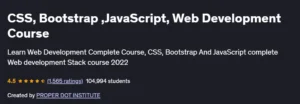Building the Frontend of Python Web Applications with Streamlit
Learn to build and deploy interactive Python web apps with Streamlit—master widgets, layouts, visuals, state management, and Docker deployment in this hands-on Educative course.
What will you learn in Building the Frontend of Python Web Applications with Streamlit Course
- Set up and configure Streamlit to build interactive Python web applications
- Use Streamlit widgets (sliders, buttons, text inputs) to capture user input dynamically
- Display data with tables, charts (Matplotlib, Altair), and maps for rich visualizations
- Organize layouts and themes using columns, containers, and custom CSS
- Manage application state, caching, and handle user-triggered callbacks
- Integrate external APIs, authentication, and deploy Streamlit apps to production
Program Overview
Module 1: Introduction to Streamlit & Setup
⏳ 1 day
Topics: Installing Streamlit, project structure, running the first app
Hands-on: Create and launch a “Hello, Streamlit!” app
Module 2: Widgets & User Input
⏳ 1 day
Topics: Input widgets (text inputs, sliders, checkboxes), form handling
Hands-on: Build a simple BMI calculator with interactive inputs
Module 3: Data Display & Visualization
⏳ 1 day
Topics: Displaying DataFrames, Matplotlib/Altair charts, map components
Hands-on: Render a COVID-19 time-series chart and interactive map
Module 4: Layouts, Themes & Styling
⏳ 1 day
Topics: Columns, expanders, tabs, custom themes, CSS injection
Hands-on: Design a two-column dashboard with dark and light theme toggles
Module 5: Media, Markdown & Interactivity
⏳ 1 day
Topics: Displaying images, audio/video, Markdown formatting, callbacks
Hands-on: Create an interactive image gallery with caption filters
Module 6: State Management & Caching
⏳ 1 day
Topics: Session state, caching data and functions for performance
Hands-on: Cache expensive API calls and preserve user selections across reruns
Module 7: Integrations & Authentication
⏳ 1 day
Topics: Consuming REST APIs, OAuth basics, embedding third-party content
Hands-on: Build a login-protected news reader app using a public API
Module 8: Deployment & Scaling
⏳ 1 day
Topics: Dockerizing Streamlit apps, Streamlit Cloud, CI/CD pipelines
Hands-on: Containerize your app and deploy to Streamlit Community Cloud
Get certificate
Job Outlook
- Streamlit expertise is highly valued for roles like Data Scientist, BI Developer, and Python Web Developer
- Common industries include fintech, healthcare analytics, and SaaS startups leveraging rapid prototyping
- Salaries range from $80,000 to $130,000+ depending on experience and location
- Skills in building data-driven dashboards and deploying Python apps accelerate career growth in data-focused teams
- Focused on real-world, data-driven use cases with live coding exercises
- Covers end-to-end workflow from prototyping to deployment
- Emphasis on performance optimization and state management
- Advanced custom component development (React plugins) is not covered
- Limited depth on large-scale architecture or multi-page apps
Specification: Building the Frontend of Python Web Applications with Streamlit
|
FAQs
- No prior frontend experience is required; basic Python knowledge is sufficient.
- The course introduces Streamlit and frontend concepts for Python web apps step by step.
- Beginners can follow along with hands-on exercises to create interactive web interfaces.
- Knowledge of HTML, CSS, or JavaScript can help but is not mandatory.
- By the end, learners can build functional, interactive frontends for Python applications.
- Yes, the course covers interactive elements like buttons, sliders, input boxes, and forms.
- Learners practice capturing user input and dynamically updating application content.
- Techniques for arranging layouts and widgets to enhance user experience are included.
- Hands-on projects demonstrate practical applications of these interactive components.
- Advanced UI customization may require additional exploration beyond the course.
- Yes, the course teaches integrating data visualization libraries like Matplotlib, Plotly, or Seaborn with Streamlit.
- Learners practice displaying charts, graphs, and tables interactively in web apps.
- Skills help build dashboards, reports, or analytical tools with real-time updates.
- Techniques include customizing visuals and updating them dynamically based on user input.
- Advanced visualization techniques may require additional study.
- Yes, the course introduces deployment concepts to make Streamlit apps accessible online.
- Learners practice hosting applications on platforms like Streamlit Cloud or other web servers.
- Guidance includes environment setup, dependencies management, and sharing URLs.
- Deploying projects helps showcase applications to potential users or employers.
- Advanced deployment strategies like CI/CD pipelines may require further learning.
- Yes, the course focuses on building functional frontends that interact with Python backends.
- Learners practice creating user interfaces that handle data input, processing, and output.
- Integration with Python scripts, APIs, or databases is demonstrated for real-world applications.
- Projects help learners understand full-stack workflows, even if backend work is minimal.
- Advanced full-stack features may require additional courses or experience.





